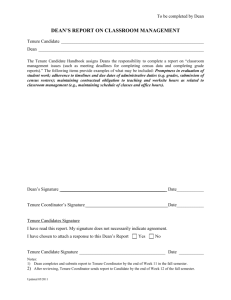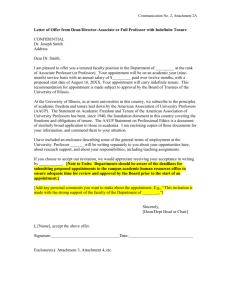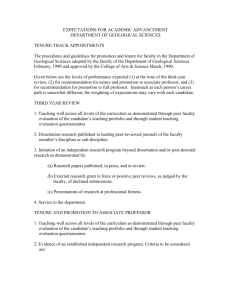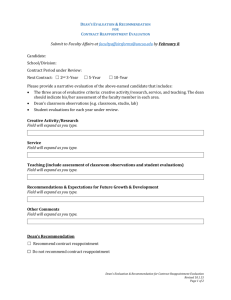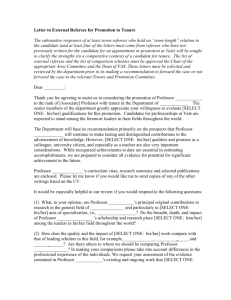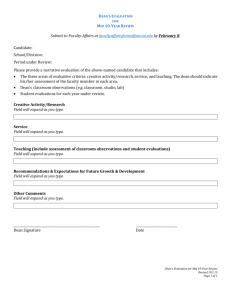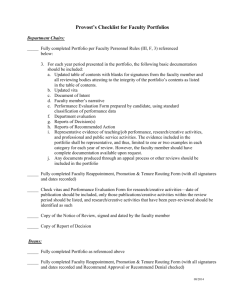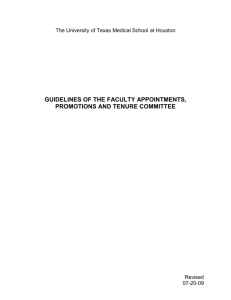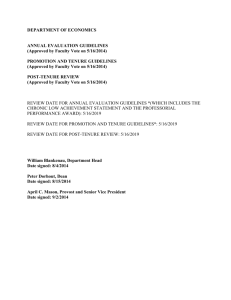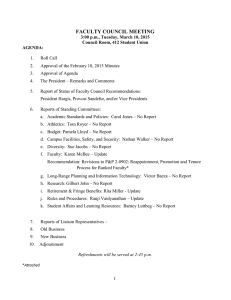Page of 4 College of Health Sciences Clinical Faculty Adopted
advertisement
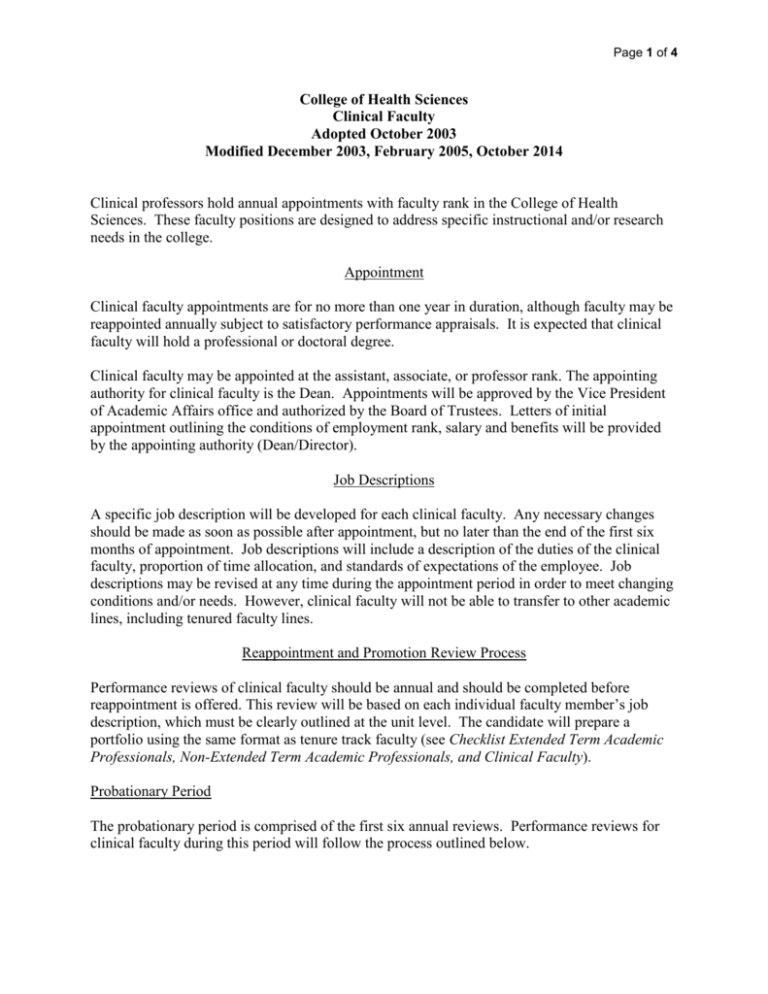
Page 1 of 4 College of Health Sciences Clinical Faculty Adopted October 2003 Modified December 2003, February 2005, October 2014 Clinical professors hold annual appointments with faculty rank in the College of Health Sciences. These faculty positions are designed to address specific instructional and/or research needs in the college. Appointment Clinical faculty appointments are for no more than one year in duration, although faculty may be reappointed annually subject to satisfactory performance appraisals. It is expected that clinical faculty will hold a professional or doctoral degree. Clinical faculty may be appointed at the assistant, associate, or professor rank. The appointing authority for clinical faculty is the Dean. Appointments will be approved by the Vice President of Academic Affairs office and authorized by the Board of Trustees. Letters of initial appointment outlining the conditions of employment rank, salary and benefits will be provided by the appointing authority (Dean/Director). Job Descriptions A specific job description will be developed for each clinical faculty. Any necessary changes should be made as soon as possible after appointment, but no later than the end of the first six months of appointment. Job descriptions will include a description of the duties of the clinical faculty, proportion of time allocation, and standards of expectations of the employee. Job descriptions may be revised at any time during the appointment period in order to meet changing conditions and/or needs. However, clinical faculty will not be able to transfer to other academic lines, including tenured faculty lines. Reappointment and Promotion Review Process Performance reviews of clinical faculty should be annual and should be completed before reappointment is offered. This review will be based on each individual faculty member’s job description, which must be clearly outlined at the unit level. The candidate will prepare a portfolio using the same format as tenure track faculty (see Checklist Extended Term Academic Professionals, Non-Extended Term Academic Professionals, and Clinical Faculty). Probationary Period The probationary period is comprised of the first six annual reviews. Performance reviews for clinical faculty during this period will follow the process outlined below. Page 2 of 4 Peers. Depending upon academic unit culture, tenured faculty and clinical associate and full professors shall review the portfolio and submit recommendations to the academic unit head. The candidate may request others to vote as well. Academic Unit Head. The academic unit head shall formulate a written recommendation. The candidate shall sign the evaluation form to indicate having reviewed the portfolio, including all written recommendations. The candidate may also add a letter of response. In cases where the recommendation is to reappoint, the academic unit head forwards a copy of the signed evaluation form and the reappointment letter to the college dean. In cases where the recommendation is not to reappoint, the academic unit head forwards the portfolio and all recommendations to the dean of the college. College Tenure and Promotion Committee. The dean of the college may seek recommendations from the college tenure and promotion committee, augmented by a set of clinical faculty. College Dean. The dean of the college shall formulate a final written decision. The candidate shall sign the evaluation form to indicate having reviewed the portfolio, including all written recommendations. The candidate may also add a letter of response. Post-Probationary Review Cycles Post-probationary period reviews will be conducted at the college level in six-year cycles. Following the probationary period, performance reviews for clinical faculty will be completed by the academic unit head on an annual basis. Peer review of clinical faculty will take place commensurate with the post-tenure review protocol at the unit level. The candidate’s portfolio, including the evaluation forms and written comments, must be forwarded to the dean of the college when the annual review results in a recommendation to not reappoint and/or when the “post-tenure” review occurs at the end of a post-probationary review cycle (i.e., every six years). Clinical faculty are eligible for promotion. Assistant clinical faculty can apply for promotion to associate clinical faculty at any time, although typically not before completing six years as an assistant clinical professor. Associate clinical faculty can apply for promotion to clinical professor, but not typically before six years as associate clinical professor. Following promotion, associate clinical professionals and clinical professors will be reviewed using the process outlined for post-tenured faculty. Upon promotion, clinical faculty will be eligible for a 10% increase in salary. Where deemed relevant and appropriate by the appointing authority, internal and external letters of reference should be included as part of the portfolio for promotion. The procedures used for soliciting and handling these letters should follow the prescriptions given in University Regulation 5-803 for faculty tenure and promotion cases. These letters may appear in a separate Page 3 of 4 envelope to preserve confidentiality, but they must be available in their original forms to people at all levels of review. Leaves of Absence Professional Development Leave After six academic years and promotion to associate clinical professor, clinical faculty are eligible for professional development leave. Initial requests for professional development leave may be submitted no earlier than the seventh year of academic service. Six years of academic service must precede each period of professional development leave, although no right accrues automatically through lapse of time. When feasible, professional development leaves (with or without salary) will be encouraged to allow faculty to enhance clinical performance, conduct clinical research or undertake planned activities related substantially to the clinical faculty’s role at the University. Funding of professional development leaves will be the budgetary responsibility of the academic unit involved. Professional leave plans must be flexible and may vary from unit to unit within the CHS. A clinical faculty who fails to return to the University for at least one academic year following professional development leave shall be obliged to repay the amount of compensation received from the University during the period of the leave. Other Leave Clinical faculty will be eligible for emergency or short-term leave with pay, leave without pay, sick leave, bereavement leave, and family and medical leave as outlined in Trustee Regulation governing academic personnel. Page 4 of 4 Excerpts from University Regulations (italics added for emphasis) Faculty Designation (UW 5-1.B.1.f) Clinical professor shall be the title granted to those employed to teach in health care related programs offered by the University; the college dean and other appropriate academic officers will determine the appropriate academic qualifications and professional experience for these faculty. Such appointments shall be for not more than one year in duration; however, one may be reappointed annually subject to a satisfactory annual performance evaluation and available funding. Service as a clinical professor does not entitle one to tenure and its privileges. Faculty Appointment (UW 5-1.C.1.b) Temporary appointments with faculty rank may be made to address specific instructional or research needs. Such appointments shall not be for more than one year in duration; however, temporary faculty may be reappointed annually subject to a satisfactory performance evaluation. Service as a temporary professor does not entitle one to tenure and its privileges. Reappointment, Tenure and Promotion (UW 5-1.D.) Candidates for reappointment, tenure and promotion are evaluated on the academic functions they are expected to perform and the evaluations will appropriately recognize the proportion of time allocated and expected for the particular functions by the candidates at each professional rank.
